This kind of post fascinates me. One thing I don't understand is the settlement timeline posted by Ingenuity. It shows the original T&R estimate was 4.5-5.5" yet by end of construction they already had 6" of settlement and merely updated their prediction to show 10.3-12.3". Not being structural/geo I don't understand. If you exceeded your lifetime settlement estimate just at the completion of construction, you can simply update the estimate?
Navigation
Install the app
How to install the app on iOS
Follow along with the video below to see how to install our site as a web app on your home screen.
Note: This feature may not be available in some browsers.
More options
Style variation
-
Congratulations TugboatEng on being selected by the Eng-Tips community for having the most helpful posts in the forums last week. Way to Go!
You are using an out of date browser. It may not display this or other websites correctly.
You should upgrade or use an alternative browser.
You should upgrade or use an alternative browser.
SF tower settlement 25
- Thread starter hokie66
- Start date
- Status
- Not open for further replies.
"If you exceeded your lifetime settlement estimate just at the completion of construction, you can simply update the estimate?"
Why not? We discovered an earthquake fault during construction of a Navy wharf. We just lowered the specified safety factors on everything.
Why not? We discovered an earthquake fault during construction of a Navy wharf. We just lowered the specified safety factors on everything.
RVAmeche - It helps to understand the scope of Treadwell & Rollo's participation in the project. They provided the Preliminary & Final Geotechnical reports in advance of construction and performed Pile Driving field inspection followed by a report of the suitability of the piles driven to preform the work as established by the Structural Engineer who designed the piling footprint & determined the loading. The initial estimate of settlement was part of the Final Geotechnical Report.
We don't know what caveats Treadwell & Rollo may have issued, subsequent to the completion of the pile driving. They provided Millennium Partners with a letter, green-lighting the piling but there was supplemental information to the letter that is not included in the publicly available documents. Insitu-Tech, the firm hired to perform PDA & Cap-Wap testing of the Indicator Piles driven and intended to provide Treadwell & Rollo with greater insight as to the ground conditions; certainly had concerns about the lack of uniform pile response to driving & ground conditions. Neither his letter or the test data for the tested piles is available to the public. We are only given 4 of the 25 Indicator Pile reports and they are on the South end of the foundation, which is the most uniform & stable. Subsequent to the Indicator Pile program, Treadwell & Rollo did revise their Pile Length site map. It is unfortunate that Treadwell & Rollo missed an area that should have had longer piles but on the whole their revised Pile Length site map was astonishingly intuitive.
This represents the bulk of Treadwell & Rollo's work. The shoring design & engineering, the ground water/dewatering scheme, ground water monitoring, areal settlement & tower settlement were, as near as I can tell, contracts issued by the General Contractor.
Treadwell & Rollo had no control over any of these elements nor the pace of construction of the high rise. In Treadwell & Rollo's response letter to the SF Dept. of Building Inspection, they cite extensive dewatering & a longer than anticipated schedule for the adjacent 5 level basement of the podium & mid-rise as contributing to the excessive settlement. These two elements alone are sufficient cause for Treadwell & Rollo to respectfully revise their estimate.
I can only guess that Treadwell & Rollo provided the revised estimate as a Custodial Response to their earlier estimate. They were hardly required to do any in depth consultation, since they had no control over so many elements that effected the settlement. In any case, the SF Dept of Building Inspection completely ignored the settling, even though at the time they signed off on the Occupancy Permit, the basement of the tower was riddled with cracks.
Treadwell & Rollo were made out to be derelict early on because they were involved in a similar Concrete High-Rise at the opposite end of the Transbay Transit Center project, that a number of outside experts weighed in on. The most notable stated that the 80 Natoma building would settle by 9+ inches as opposed to the 2 inches the T&R Geotech had forecast. It all looks quite damning in the press but if one looks at the 80 Natoma project and compares it to the counter arguments, the counter arguments are invalidated because they failed to account for the "Compensated Foundation" of 4 to 5 levels of basement parking at 80 Natoma.
The 80 Natoma project was ultimately halted because it interfered with the rail alignment of the Transbay Transit Center. The 80 Natoma property owners probably took advantage of the Transbay Joint Powers Authority, ultimately selling the land to the TJPA. I think they were short sighted. The 1990's permit for the building allowed for substantial parking, which being so close to the Transbay Transit Center, would have been a pot of gold.
We don't know what caveats Treadwell & Rollo may have issued, subsequent to the completion of the pile driving. They provided Millennium Partners with a letter, green-lighting the piling but there was supplemental information to the letter that is not included in the publicly available documents. Insitu-Tech, the firm hired to perform PDA & Cap-Wap testing of the Indicator Piles driven and intended to provide Treadwell & Rollo with greater insight as to the ground conditions; certainly had concerns about the lack of uniform pile response to driving & ground conditions. Neither his letter or the test data for the tested piles is available to the public. We are only given 4 of the 25 Indicator Pile reports and they are on the South end of the foundation, which is the most uniform & stable. Subsequent to the Indicator Pile program, Treadwell & Rollo did revise their Pile Length site map. It is unfortunate that Treadwell & Rollo missed an area that should have had longer piles but on the whole their revised Pile Length site map was astonishingly intuitive.
This represents the bulk of Treadwell & Rollo's work. The shoring design & engineering, the ground water/dewatering scheme, ground water monitoring, areal settlement & tower settlement were, as near as I can tell, contracts issued by the General Contractor.
Treadwell & Rollo had no control over any of these elements nor the pace of construction of the high rise. In Treadwell & Rollo's response letter to the SF Dept. of Building Inspection, they cite extensive dewatering & a longer than anticipated schedule for the adjacent 5 level basement of the podium & mid-rise as contributing to the excessive settlement. These two elements alone are sufficient cause for Treadwell & Rollo to respectfully revise their estimate.
I can only guess that Treadwell & Rollo provided the revised estimate as a Custodial Response to their earlier estimate. They were hardly required to do any in depth consultation, since they had no control over so many elements that effected the settlement. In any case, the SF Dept of Building Inspection completely ignored the settling, even though at the time they signed off on the Occupancy Permit, the basement of the tower was riddled with cracks.
Treadwell & Rollo were made out to be derelict early on because they were involved in a similar Concrete High-Rise at the opposite end of the Transbay Transit Center project, that a number of outside experts weighed in on. The most notable stated that the 80 Natoma building would settle by 9+ inches as opposed to the 2 inches the T&R Geotech had forecast. It all looks quite damning in the press but if one looks at the 80 Natoma project and compares it to the counter arguments, the counter arguments are invalidated because they failed to account for the "Compensated Foundation" of 4 to 5 levels of basement parking at 80 Natoma.
The 80 Natoma project was ultimately halted because it interfered with the rail alignment of the Transbay Transit Center. The 80 Natoma property owners probably took advantage of the Transbay Joint Powers Authority, ultimately selling the land to the TJPA. I think they were short sighted. The 1990's permit for the building allowed for substantial parking, which being so close to the Transbay Transit Center, would have been a pot of gold.
-
3
- #206
No doubt most of you here on Eng-Tips / Engineering Failures & Disasters Forum have heard or read in the news about the cracked window on the 36th floor of the Millennium Tower. The SF Dept. of Building Inspection was none too pleased to hear about the cracked window by way of an inquiry by a News Reporter asking for comment. They followed up with a dire letter, requiring a laundry list of inspections & reports & sidewalk protection with the possibility of issuing a Yellow-Tag on the building if the Millennium HOA failed to exercise diligence. It doesn't help that currently the Window Washing Crane for the tower is out of service and the part is on back-order. One of the news reports now gives the total depth of settling as 18 inches. Two more than a year ago.
Video: Link
Yellow Tag: Link
Crane: Link
The crack may just be a result of a defect but it may also be true that the defect was triggered by the stress the building is experiencing. While unlikely to have any had any impact on the window failure, the crack is directly above the location in the basement where the pile connection test is/was taking place.
I have pinpointed the location for your curiosity.

The window is on the outside corner of a flat slab and is the outside pane of a double pane window.
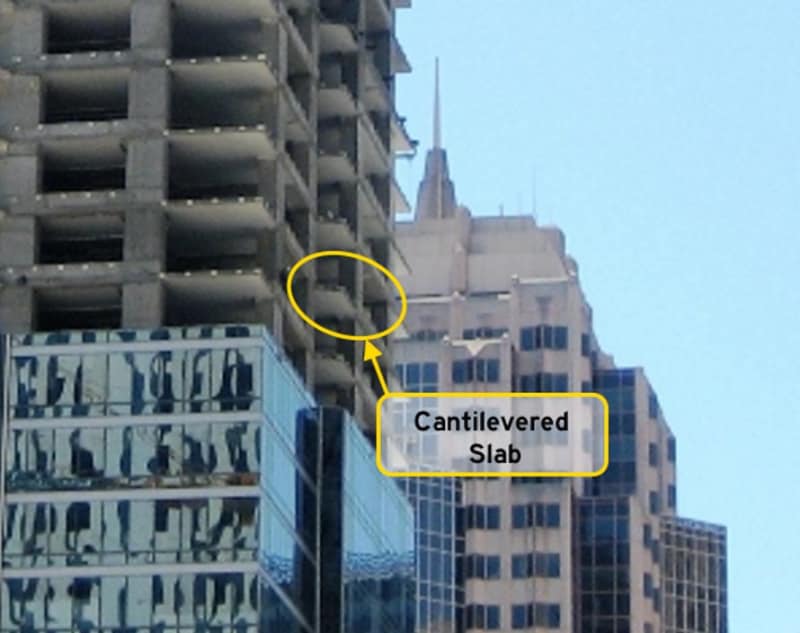
The window is on the north face towards Missions St. This is the direction with the 2+ inches of lean.
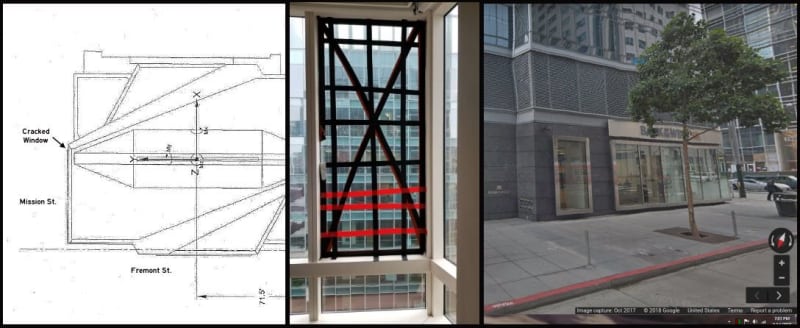
Attempts have been made to inspect the window using a drone but the drone lost its GPS signal & crashed 3 times. They will now have a field technician/engineer repel down the side of the building to inspect & secure the window with tape.
There is also another building stabilizing scheme being mulled over. One that approaches the work from the north & west perimeter of the building. It involves installing piles down through the city owned sidewalk and supporting the building on an extension of the foundation.
Video: Link
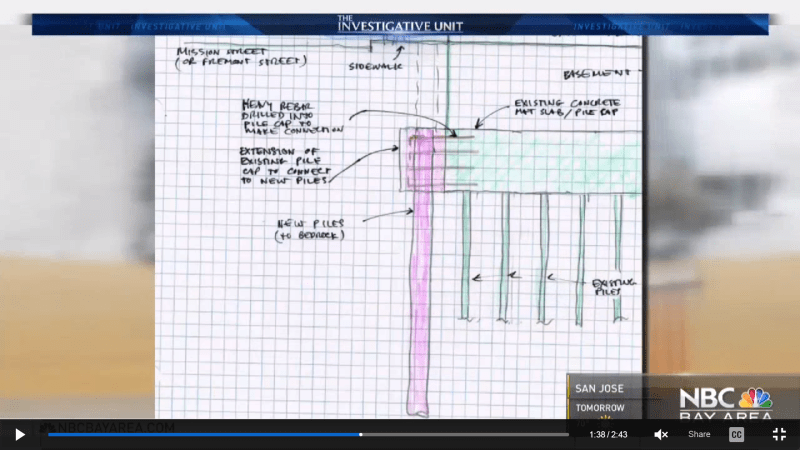
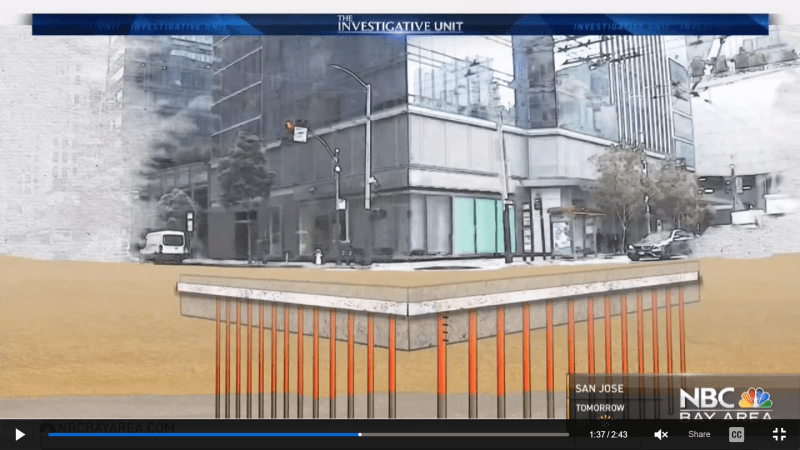
This isn't much different than a scheme I toyed around with last year.
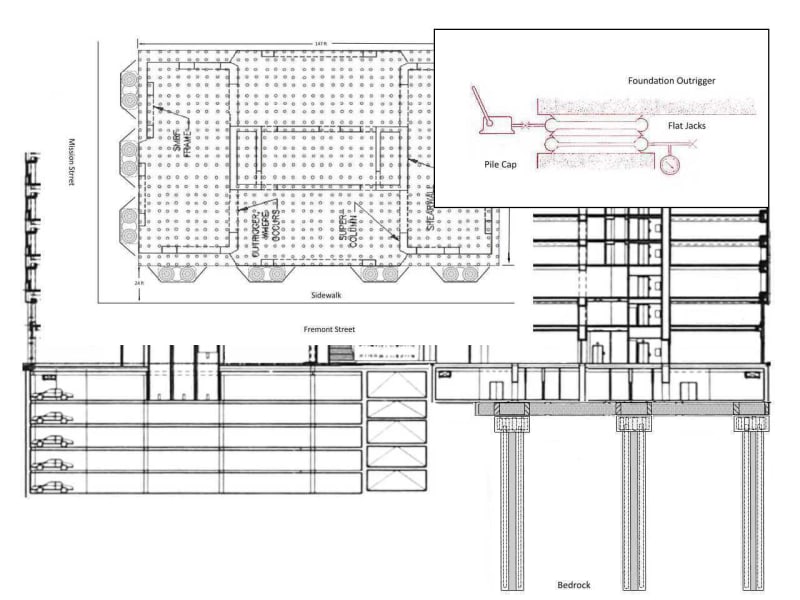
It just puts a lot of stress on parts of the building that might just cause other problems. For instance the 3 foot thick cantilever slab off of the 10 foot thick mat foundation on the south end of the building is already under great strain. It doesn't help that the Older PG&E vault below the 3 foot cantilever slab, likely is holding up the southwest corner of the tower.
SF Supervisor Aaron Peskin has called for another hearing on Sept. 22nd. It isn't on the City calendar, so it remains to be seen when the meeting will actually happen but he is now convinced that there are holes in the record and he wants City employees past & present to testify.
Video: Link
Yellow Tag: Link
Crane: Link
The crack may just be a result of a defect but it may also be true that the defect was triggered by the stress the building is experiencing. While unlikely to have any had any impact on the window failure, the crack is directly above the location in the basement where the pile connection test is/was taking place.
I have pinpointed the location for your curiosity.

The window is on the outside corner of a flat slab and is the outside pane of a double pane window.

The window is on the north face towards Missions St. This is the direction with the 2+ inches of lean.

Attempts have been made to inspect the window using a drone but the drone lost its GPS signal & crashed 3 times. They will now have a field technician/engineer repel down the side of the building to inspect & secure the window with tape.
There is also another building stabilizing scheme being mulled over. One that approaches the work from the north & west perimeter of the building. It involves installing piles down through the city owned sidewalk and supporting the building on an extension of the foundation.
Video: Link


This isn't much different than a scheme I toyed around with last year.

It just puts a lot of stress on parts of the building that might just cause other problems. For instance the 3 foot thick cantilever slab off of the 10 foot thick mat foundation on the south end of the building is already under great strain. It doesn't help that the Older PG&E vault below the 3 foot cantilever slab, likely is holding up the southwest corner of the tower.
SF Supervisor Aaron Peskin has called for another hearing on Sept. 22nd. It isn't on the City calendar, so it remains to be seen when the meeting will actually happen but he is now convinced that there are holes in the record and he wants City employees past & present to testify.
Did they ever resolve the matter about the fire stopping at the floor/wall interface being shifted to provide gaps and no fire resistance?
An overhead protection system should work really well... A large piece of glass could 'glide' across the street... be interesting to see how that works... I recall way back when, there was a building in Boston that was losing glazing... Handcock building if I recall...
Dik
An overhead protection system should work really well... A large piece of glass could 'glide' across the street... be interesting to see how that works... I recall way back when, there was a building in Boston that was losing glazing... Handcock building if I recall...
Dik
Dik said:Did they ever resolve the matter about the fire stopping at the floor/wall interface being shifted to provide gaps and no fire resistance?
I thought the issue of the fire stopping had been addressed, at least for the owner of the condo who made the original complaint. There may have been a subsequent requirement to test other units. In one of the many news reports, there is some mention of fire stop inspections in the same vertical location a few floors down but "experts" didn't believe the work had anything to do with the cracked window. At one time I tried to position the location of the condo with the fire stop problem but it is difficult to determine if the floor of the condo is a 6 unit floor or a 4 unit floor. The condo was on the 31st floor and if it was a four unit floor it could be in the same vertical line.
I recall there was a lot of speculation over the fire stop being an issue as a result of the curtain wall having moved, creating the gap and possibly that the curtain wall manufacturer & contractor were being sued.
If indeed the fire stop work of the original complaint & the subsequent work are all in the same vertical building line, then it would seem they have a progressive failure. It is a tall slender building but wouldn't there be a horizontal component if it is a progressive failure?
Contour Elevation gif 2010-2014
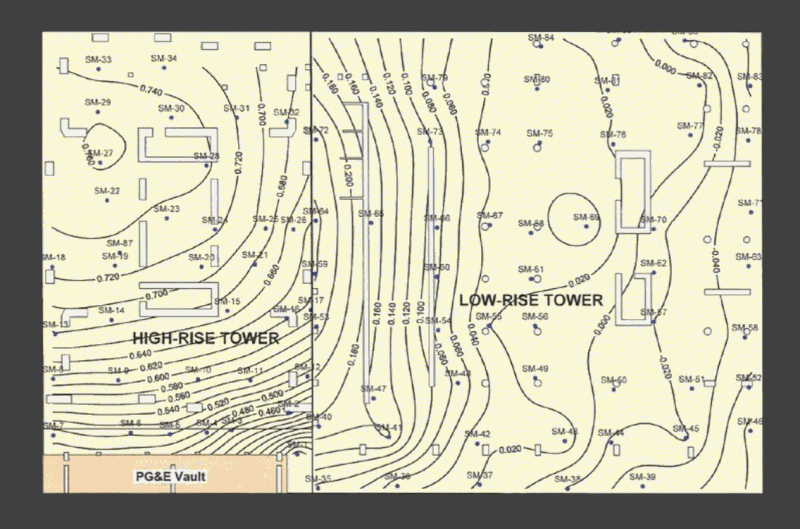
Floor Elevations gif 2010-2014
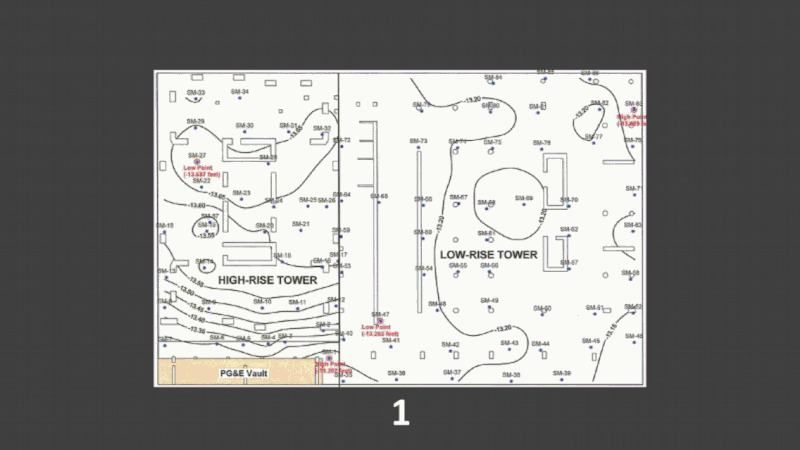
Fire engineering is a very reactive regulatory regime. Plenty of code compliant curtain wall systems that really fail to meet the objectives of fire safety.
The fallout from the Grenfell Tower tragedy is still occurring across the world. Plenty of people saw the writing on the wall and there were even other minor fires. However it took 72 deaths for the issue to be taken seriously.
Just a modern day version of Triangle Shirtwaist Factory fire
The fallout from the Grenfell Tower tragedy is still occurring across the world. Plenty of people saw the writing on the wall and there were even other minor fires. However it took 72 deaths for the issue to be taken seriously.
Just a modern day version of Triangle Shirtwaist Factory fire
Different thought on the building settlement.
Read both reports on 301 Mission Street, and one on Transbay.
hamjohn
Read both reports on 301 Mission Street, and one on Transbay.
hamjohn
909 said:The fallout from the Grenfell Tower tragedy is still occurring across the world.
Little of it appears to be happening in the UK... just business as usual.
Dik
SF took no chances on a nearby new tower citing creep of nearby building on shorter piles. 5&6 ft dia. piles 260 feet into bedrock.
Phil1934 - 181 Fremont is an interesting building, in that it is intended to be earthquake "resilient". That is, it is designed to such a high standard that it is suppose to remain functional & occupied, post earthquake. It is also highly instrumented.
hamjohn - Carl Chan makes some interesting points and he obviously spent as much if not more time researching both the TJPA & 301 Mission as I have. He makes an interesting point about the bracing for the podium excavation. Namely that the upper bracing is fixed to the tower, whereas the two lower tiers of bracing are fixed to the shoring wall below the tower. This certainly provides for the upper bracing & the lower bracing to behave differently.
As extensive as his research was, he may have missed the early tests done on timber pile extraction and settlement. The old Transbay Terminal adjacent to the Millennium Tower had an 11 to 13 foot deep basement. Demolition of the old terminal would not have represented any great change to the soil beneath the terminal. More so because it was incrementally demolished and back-filled almost to street level.
Testing:
With ground cleared of the old terminal debris - on the west end of the TJPA, they tested a number of CDSM shoring shoring wall schemes, while on the east end (Zone 4) aka Millennium Tower zone, they performed a timber pile extraction & ground effect test. An area of piles was select and ground elevations recorded & instrumented, then a 30ft to 40ft pile was extracted and areal ground subsidence recorded. They also performed this test while quickly following up with tremie placed @50psi bentonite/concrete. I believe the method chosen for removing the timber piles was that piles could only be removed one at a time and the hole filled with tremie concrete before the adjacent pile could be extracted. When the pile extractions were done adjacent to structures with shallow basements/footing or other sensitive criteria, they vibrated casings in place, extracted the piles, filled the casing with concrete & extracted the casing (one at a time). Indeed, this casing method was used on 3 timber piles adjacent to the buried old PG&E Vault
between the TJPA & Millennium Tower before the CDSM shoring wall was placed.
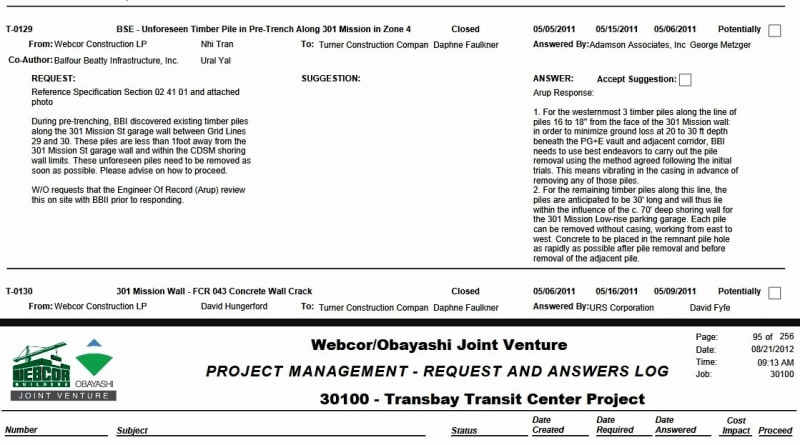
In Carl Chan's Millennium Tower Supplement, he identifies an area beneath the tower as an "abandoned shoring wall" this is actually the 25ft(wide) x 3 ft (thick) Cantilever Slab that extends off the south end of the tower foundation & flies over the older PG&E Utility Vault that remains buried between the tower & the TJPA.
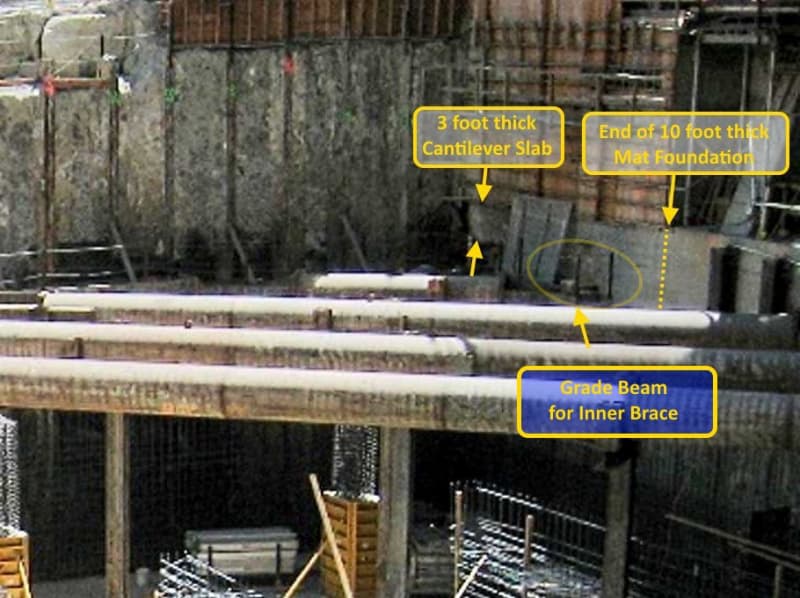
It is confusing because an identical PG&E vault was built directly over this one, in the basement of the tower on level B1. From the end of the southern end of the tower foundation a section of ~grade beam~ is incorporated into the foundation to accommodate the innermost corner brace. There are drawings showing the shoring wall stepping up to fill the space below the 3 ft cantilever slab.
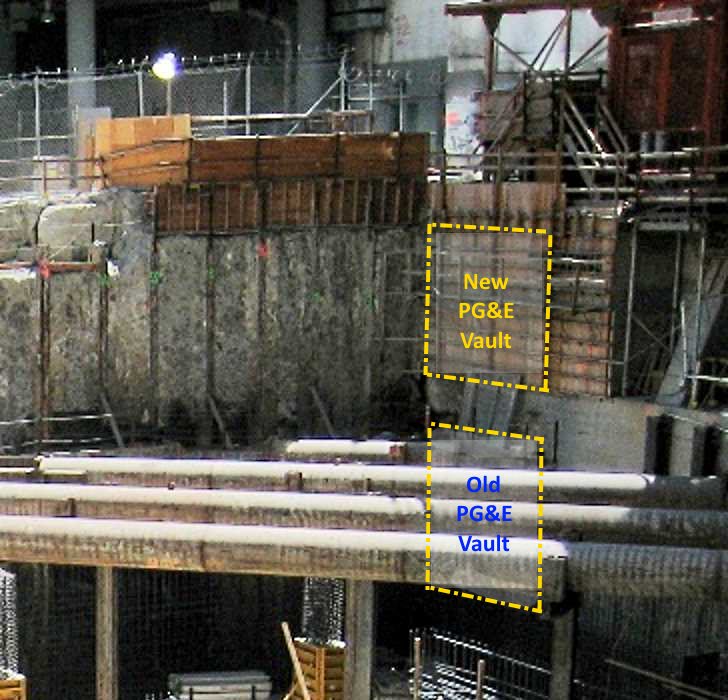
The time period in the fall of 2010, that Carl Chan denotes as a period where the tower ceased to sink is actually noted by Arup as a time when the tower briefly began to settle back in the opposite direction and can be seen in the contour .gif posted above and identified by this signature slide. This is when the tower returns to its north-west settlement.
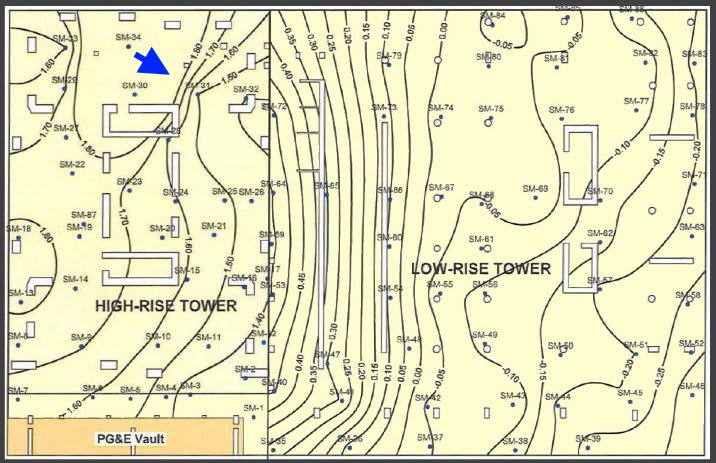
It takes place early in the TJPA's monitoring of the tower at a time when they were recording every 30 to 60 days. The tower most definitely had not stopped shifting. About the time the tower returned to its West-North-Westerly tilt there is an anecdote that an occupant in the tower heard a loud bang and felt the building shake. Perhaps this is when cracks developed in the north-west corner on levels 4 & 5 of the parking structure. This corner also represents where Webcor Bldrs. had water intrusion problems, as shown in the photo (fig. 3, pg. 3) in Carl Chan's Millennium Tower Supplement. It is worth noting that the transition zones in the different soil layers are punctuated by crust layers that can yield more resistance that the the same soil layer below the transition. The depth of the crust layers are fairly easy to identify in the 4 indicator pile tests found in the files the city has provided during the Oversight Committee hearings. There was concern about penetrating the crust layer as the pile capacity could drop.
Returning to Carl Chan's observation of the podium excavation shoring, one has to wonder how much stress the bracing was under. It appears that every panel of the entire east CDSM shoring wall showed signs of distress, as evidenced by the degree of water intrusion. Meanwhile there is virtually no water intrusion on the shoring wall beneath the tower.
East Shoring Wall:
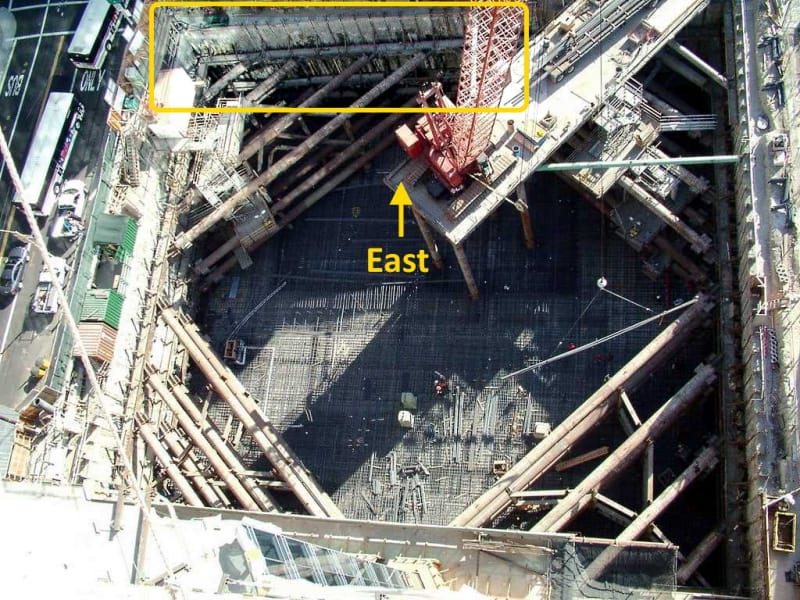
North Shoring Wall:
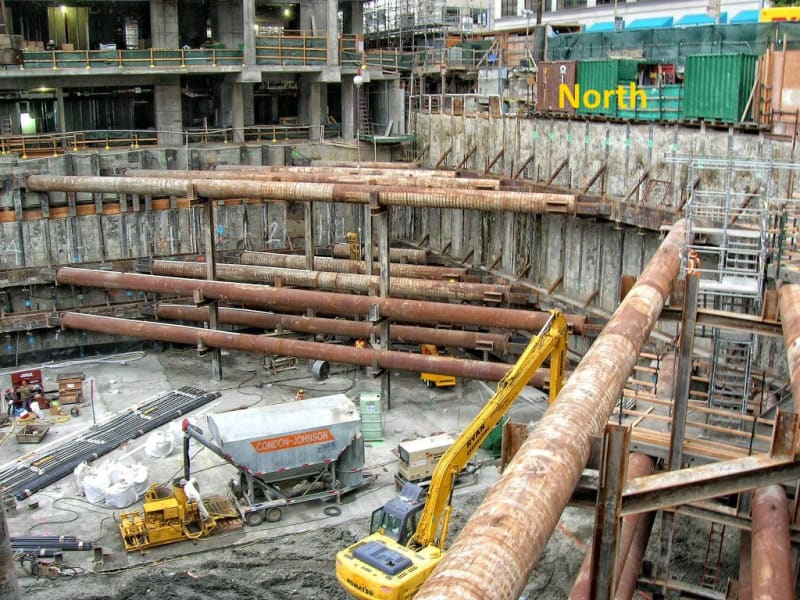
South Shoring Wall:
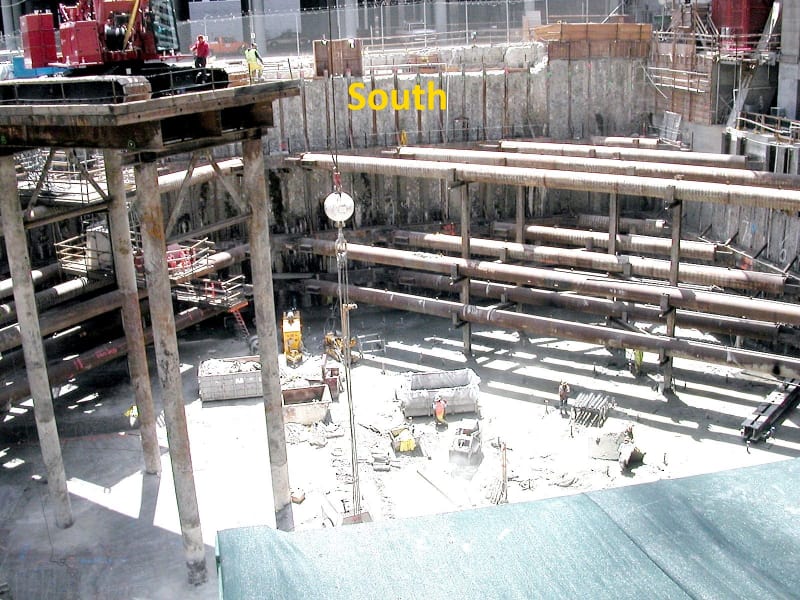
When one goes looking for an outside groundwater influence that may have accelerated the sinking of the tower, one has to look at the work that took place at 350 Mission St.(Webcor Bldrs.), before looking to the TJPA. 350 Mission St. began dewatering in May of 2013. They certainly didn't install a CDSM shoring wall 105ft deep into Old Bay Clay like the TJPA. While the TJPA started dewatering in Zone 4 shortly after 350 Mission, just how much "Areal Effect" could this dewatering have with a CDSM shoring wall 105ft deep into Old Bay Clay backed up by a 7ft thick secant buttress wall drilled 260ft down & socketed 10ft into bedrock.
350 Mission End of April:
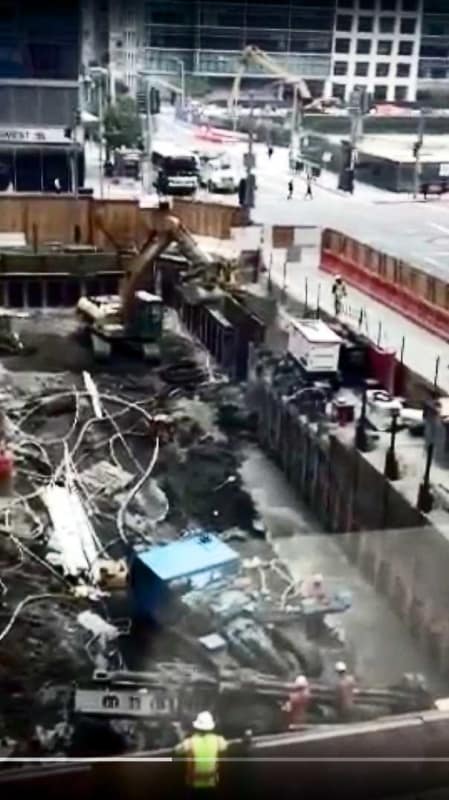
TJPA Zone 4 - Aug 10 2013
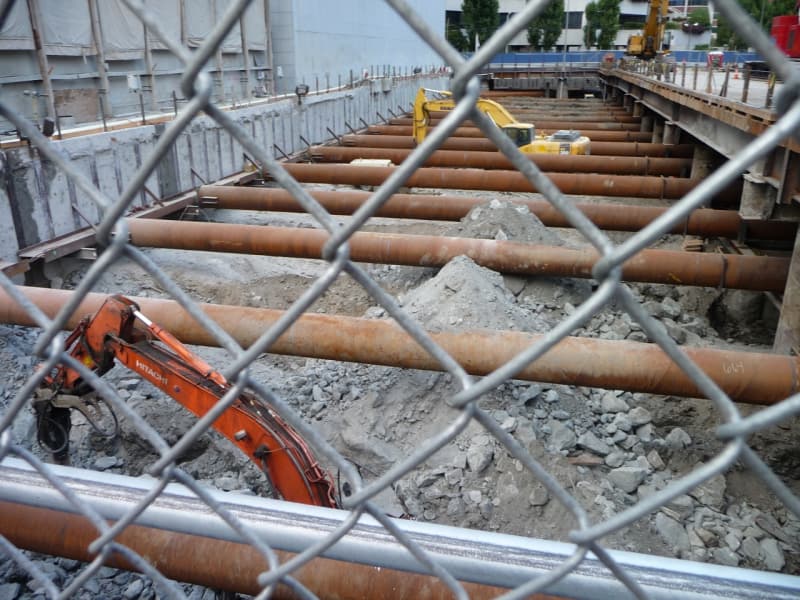
The specification for water draw down outside the TJPA excavation was -3ft based on established piezometer readings, the dewatering contractor was required to recharge the groundwater if the levels dropped below -3ft. The big "IF" is whether this was adhered to.
Dewatering:
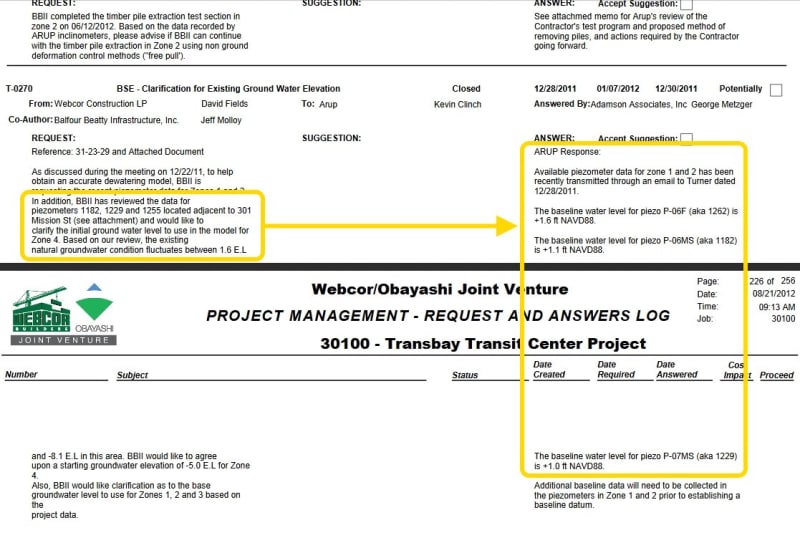
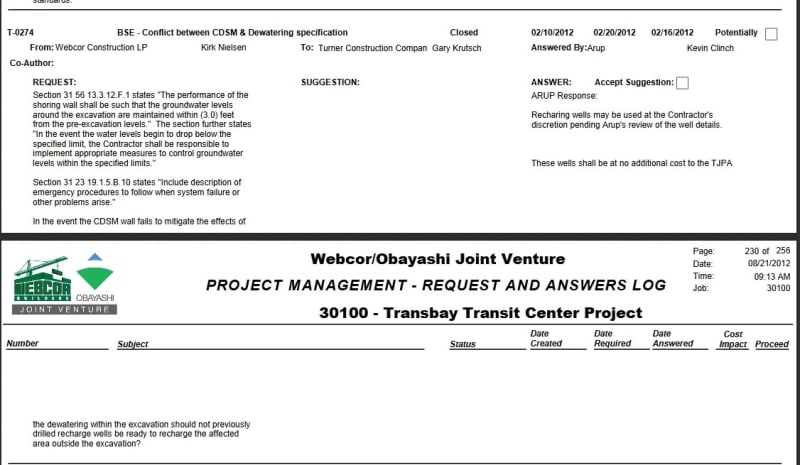
Window Update:
Permits were issued to remove wall & window sill materials in units 35B, 36B & 37B to inspect the curtain wall. The earlier Fire-Stop problem was in 31B and is at the same vertical building line. The section of floor slab is between the two sets of SMRF's which are slightly offset, accounting for the recess in the building facade. The Window offset is immediately adjacent to the east inner SMRF.
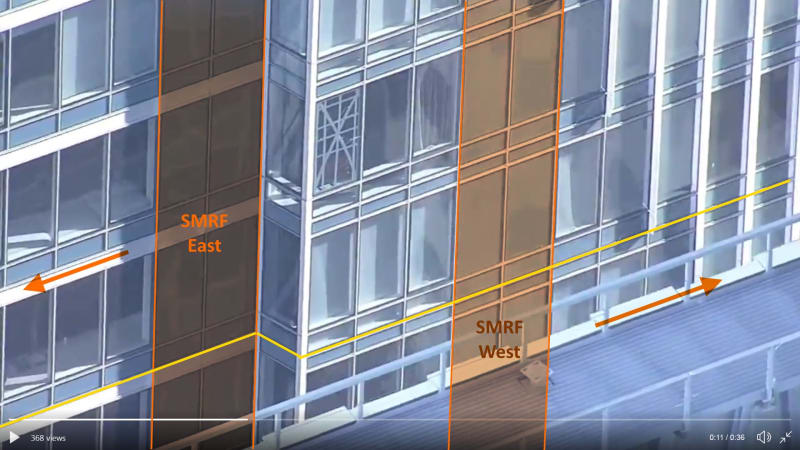
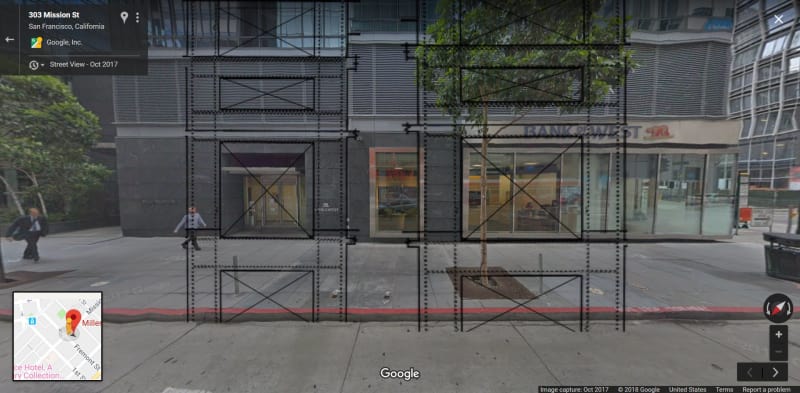
Reinforcing the External Pane of 36B![[surprise] [surprise] [surprise]](/data/assets/smilies/surprise.gif)
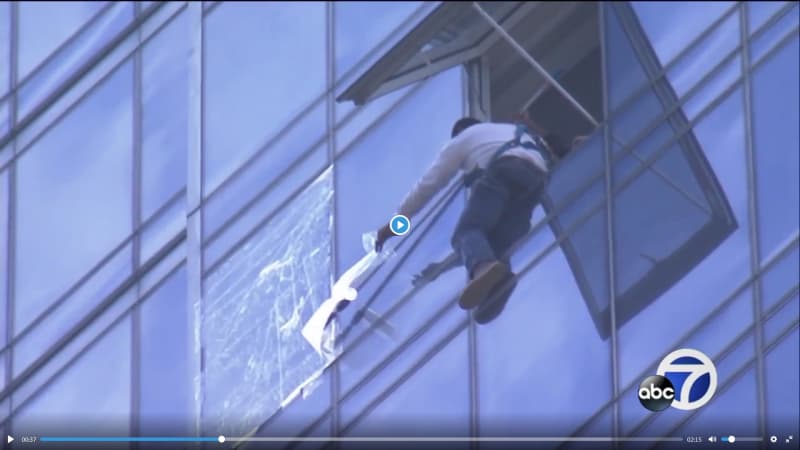
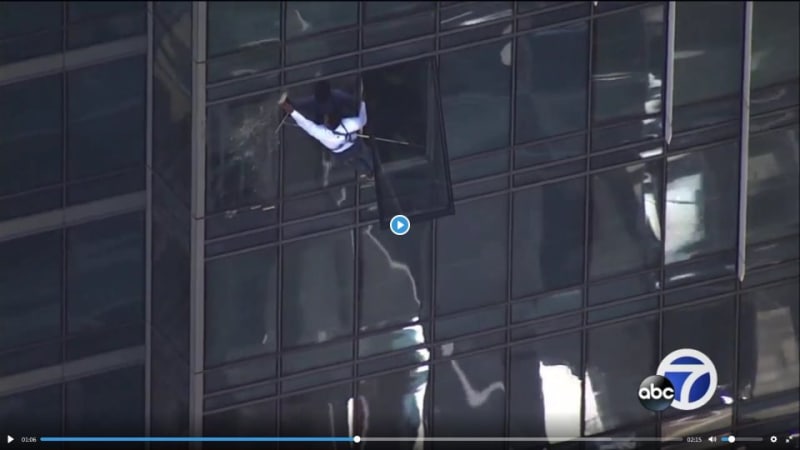
There have also been problems at street level. The sidewalk in this area has been opened up, excavated & replaced. The towers external fire hose connections are located at the base of tower at this building line. There is also a water spigot that has a history of leaking. The HOA in 2016 commissioned the installation of geotechnical instrumentation in the sidewalk in this location.

Remediation Study:
A permit has JUST been filed to drill two soil exploration borings to 250 feet deep, the name on the application is Ron Hamburger. This is to be done from the top of the Mat Foundation, presumably from the basement.
hamjohn - Carl Chan makes some interesting points and he obviously spent as much if not more time researching both the TJPA & 301 Mission as I have. He makes an interesting point about the bracing for the podium excavation. Namely that the upper bracing is fixed to the tower, whereas the two lower tiers of bracing are fixed to the shoring wall below the tower. This certainly provides for the upper bracing & the lower bracing to behave differently.
As extensive as his research was, he may have missed the early tests done on timber pile extraction and settlement. The old Transbay Terminal adjacent to the Millennium Tower had an 11 to 13 foot deep basement. Demolition of the old terminal would not have represented any great change to the soil beneath the terminal. More so because it was incrementally demolished and back-filled almost to street level.
Testing:
With ground cleared of the old terminal debris - on the west end of the TJPA, they tested a number of CDSM shoring shoring wall schemes, while on the east end (Zone 4) aka Millennium Tower zone, they performed a timber pile extraction & ground effect test. An area of piles was select and ground elevations recorded & instrumented, then a 30ft to 40ft pile was extracted and areal ground subsidence recorded. They also performed this test while quickly following up with tremie placed @50psi bentonite/concrete. I believe the method chosen for removing the timber piles was that piles could only be removed one at a time and the hole filled with tremie concrete before the adjacent pile could be extracted. When the pile extractions were done adjacent to structures with shallow basements/footing or other sensitive criteria, they vibrated casings in place, extracted the piles, filled the casing with concrete & extracted the casing (one at a time). Indeed, this casing method was used on 3 timber piles adjacent to the buried old PG&E Vault
between the TJPA & Millennium Tower before the CDSM shoring wall was placed.

In Carl Chan's Millennium Tower Supplement, he identifies an area beneath the tower as an "abandoned shoring wall" this is actually the 25ft(wide) x 3 ft (thick) Cantilever Slab that extends off the south end of the tower foundation & flies over the older PG&E Utility Vault that remains buried between the tower & the TJPA.

It is confusing because an identical PG&E vault was built directly over this one, in the basement of the tower on level B1. From the end of the southern end of the tower foundation a section of ~grade beam~ is incorporated into the foundation to accommodate the innermost corner brace. There are drawings showing the shoring wall stepping up to fill the space below the 3 ft cantilever slab.

The time period in the fall of 2010, that Carl Chan denotes as a period where the tower ceased to sink is actually noted by Arup as a time when the tower briefly began to settle back in the opposite direction and can be seen in the contour .gif posted above and identified by this signature slide. This is when the tower returns to its north-west settlement.

It takes place early in the TJPA's monitoring of the tower at a time when they were recording every 30 to 60 days. The tower most definitely had not stopped shifting. About the time the tower returned to its West-North-Westerly tilt there is an anecdote that an occupant in the tower heard a loud bang and felt the building shake. Perhaps this is when cracks developed in the north-west corner on levels 4 & 5 of the parking structure. This corner also represents where Webcor Bldrs. had water intrusion problems, as shown in the photo (fig. 3, pg. 3) in Carl Chan's Millennium Tower Supplement. It is worth noting that the transition zones in the different soil layers are punctuated by crust layers that can yield more resistance that the the same soil layer below the transition. The depth of the crust layers are fairly easy to identify in the 4 indicator pile tests found in the files the city has provided during the Oversight Committee hearings. There was concern about penetrating the crust layer as the pile capacity could drop.
Returning to Carl Chan's observation of the podium excavation shoring, one has to wonder how much stress the bracing was under. It appears that every panel of the entire east CDSM shoring wall showed signs of distress, as evidenced by the degree of water intrusion. Meanwhile there is virtually no water intrusion on the shoring wall beneath the tower.
East Shoring Wall:

North Shoring Wall:

South Shoring Wall:

When one goes looking for an outside groundwater influence that may have accelerated the sinking of the tower, one has to look at the work that took place at 350 Mission St.(Webcor Bldrs.), before looking to the TJPA. 350 Mission St. began dewatering in May of 2013. They certainly didn't install a CDSM shoring wall 105ft deep into Old Bay Clay like the TJPA. While the TJPA started dewatering in Zone 4 shortly after 350 Mission, just how much "Areal Effect" could this dewatering have with a CDSM shoring wall 105ft deep into Old Bay Clay backed up by a 7ft thick secant buttress wall drilled 260ft down & socketed 10ft into bedrock.
350 Mission End of April:

TJPA Zone 4 - Aug 10 2013

The specification for water draw down outside the TJPA excavation was -3ft based on established piezometer readings, the dewatering contractor was required to recharge the groundwater if the levels dropped below -3ft. The big "IF" is whether this was adhered to.
Dewatering:


Window Update:
Permits were issued to remove wall & window sill materials in units 35B, 36B & 37B to inspect the curtain wall. The earlier Fire-Stop problem was in 31B and is at the same vertical building line. The section of floor slab is between the two sets of SMRF's which are slightly offset, accounting for the recess in the building facade. The Window offset is immediately adjacent to the east inner SMRF.


Reinforcing the External Pane of 36B
![[surprise] [surprise] [surprise]](/data/assets/smilies/surprise.gif)


There have also been problems at street level. The sidewalk in this area has been opened up, excavated & replaced. The towers external fire hose connections are located at the base of tower at this building line. There is also a water spigot that has a history of leaking. The HOA in 2016 commissioned the installation of geotechnical instrumentation in the sidewalk in this location.

Remediation Study:
A permit has JUST been filed to drill two soil exploration borings to 250 feet deep, the name on the application is Ron Hamburger. This is to be done from the top of the Mat Foundation, presumably from the basement.
- Status
- Not open for further replies.
Similar threads
- Replies
- 0
- Views
- 1K
- Replies
- 28
- Views
- 2K
- Locked
- Question
- Replies
- 20
- Views
- 2K
- Locked
- Question
- Replies
- 7
- Views
- 640
- Replies
- 15
- Views
- 1K
